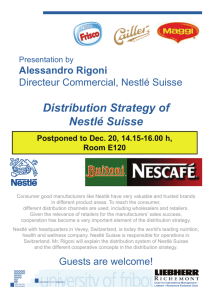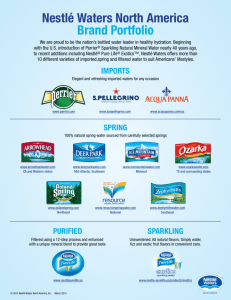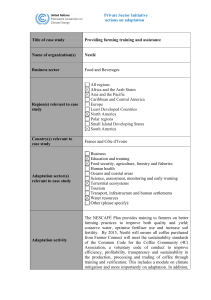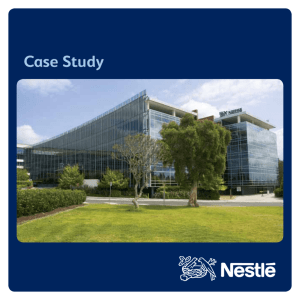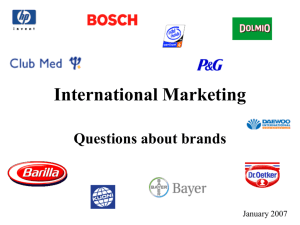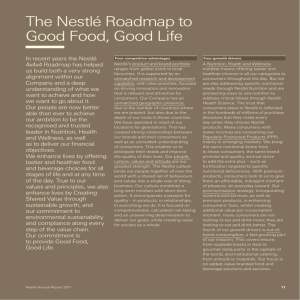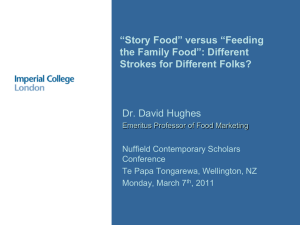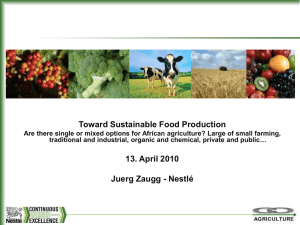STOCK TAKING OF ACTIONS AND INITIATIVES FOR SUSTAINABLE FOOD
advertisement
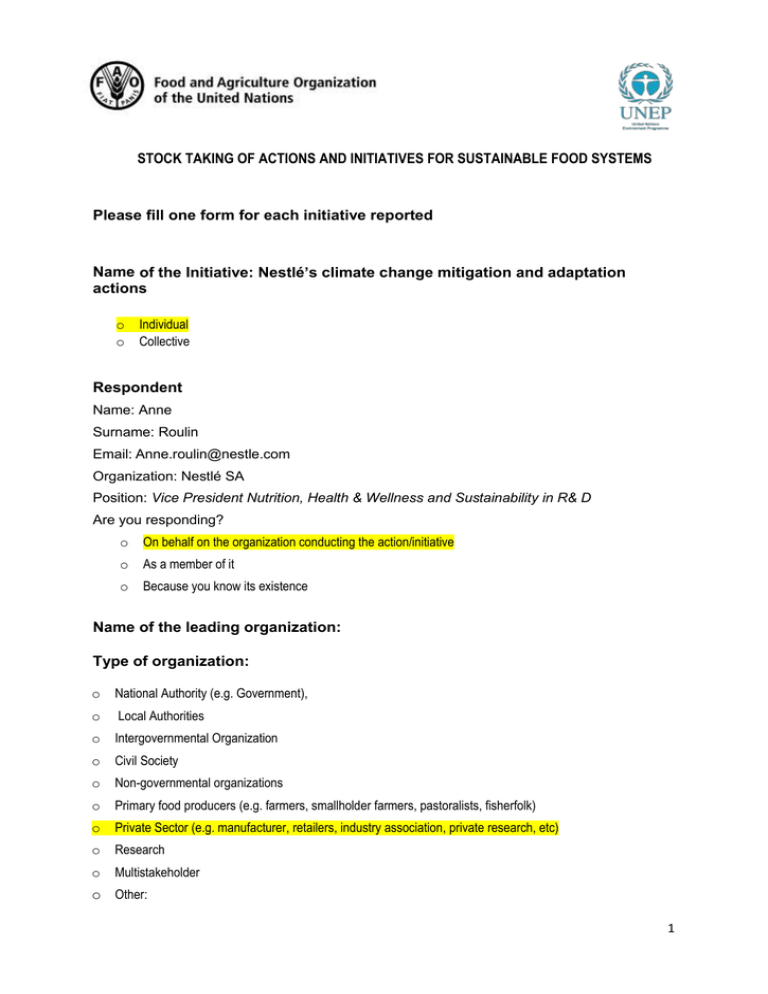
STOCK TAKING OF ACTIONS AND INITIATIVES FOR SUSTAINABLE FOOD SYSTEMS Please fill one form for each initiative reported Name of the Initiative: Nestlé’s climate change mitigation and adaptation actions o o Individual Collective Respondent Name: Anne Surname: Roulin Email: Anne.roulin@nestle.com Organization: Nestlé SA Position: Vice President Nutrition, Health & Wellness and Sustainability in R& D Are you responding? o On behalf on the organization conducting the action/initiative o As a member of it o Because you know its existence Name of the leading organization: Type of organization: o National Authority (e.g. Government), o Local Authorities o Intergovernmental Organization o Civil Society o Non-governmental organizations o Primary food producers (e.g. farmers, smallholder farmers, pastoralists, fisherfolk) o Private Sector (e.g. manufacturer, retailers, industry association, private research, etc) o Research o Multistakeholder o Other: 1 Partners (the case being): Year of the beginning of the action/ initiative: 2007 The case being, year of end: Geographical scope of the Initiative Indicate precisely Main Targeted Stage of Food Systems If appropriate, indicate precisely Local National Regional Global In all locations where Nestlé operates Input or service provision Primary Production Processing Distribution Consumption X X X X X Main dimension(s) addressed (if several of them, please indicate order of priority) o Environment o Governance o Economic o Social Main issue(s) addressed (if several of them, please indicate order of priority) o Food losses and waste o Water o Soil o Land o Air o Climate change o Biodiversity (including genetic resources) o Specific ecosystems, if yes, please precise: 2 o Energy o Pollution o Food consumption o Consumer behavior o Nutrition o Animal welfare o Fair Trade o Rural development o Land use rights o Gender issues o Youth issues o Employment o Workers rights and safety o Vulnerable groups o Poverty alleviation o Other, please specify... Main instruments used (if several of them, please indicate order of priority) o Projects o Regulations o Policy dialogue o Capacity development o Research o Knowledge dissemination o Advocacy and awareness raising o Data collection and sharing o Training, extension o Consumer information o Voluntary standards, labels o Payment for environmental services o Other? If so, please specify: Description of the Initiative (in less than 10 lines), including, as appropriate elements on size and 3 scale of the initiative: Nestlé has long sought to lead on climate change, and the goal has shaped its business practices all along the supply chain. ‘Respect is at the heart of Nestlé’, says CEO Paul Bulcke, co-chair of The Consumer Goods Forum. ‘Respect for the society in which the company operates, respect for the environment and respect for future generations.’ In practical terms. Nestlé is continuously making efforts to improve the environmental performance of its operations. Nestlé also looks to the beginning of its supply chain on environmental issues, helping farmers adapt their practices to the environmental challenges arising from climate change. At the other end of the supply chain, when it comes to keeping products like ice cream and yoghurts cool and safe to eat, Nestlé has ploughed over £160 million into finding safe carbon-neutral natural alternatives in 93% of its industrial refrigeration systems. Now all new ice cream chest freezers in Europe use natural refrigerants. These actions contribute to ensuring that Nestlé products are not only ‘tastier and healthier’, but also better for the environment along the entire chain. Results: Climate Change Mitigation Actions Reduction of direct greenhouse gas (GHG) emissions: To manufacture one kilogram of products today, Nestlé emits half of the greenhouse gases it emitted ten years ago. For example, Nestlé France’s Challerange factory, which produces milk powder for Dolce Gusto capsules, now operates a wood-fired boiler using woodchips sourced from forests certified by the Programme for the Endorsement of Forest Certification meeting 96% of the plant's fuel needs. This initiative generates approximately 8,000 tonnes CO2 savings per year and helps us to minimise the impact of energy price increases. Two other wood-fired boilers were installed at our Rosières (mashed potatoes) and Herta St Pol (sausages and hams) factories in 2013. These three wood boilers make CO2 estimated savings of 25% for Nestlé France. Use of renewable energy: In 2014, 14% of the on-site energy consumption was from renewable sources. Some examples include: In a project launched in Switzerland in 2013, the natural heat created by the source of our mineral water brand Cristalp, which emerges from the ground at 25˚C, is used to provide heat to the bottled water factory and local municipal buildings. The Cristalp factory has been running on 100% renewable energy since October 2014, a first for Nestlé Waters. Following a power purchase agreement with a Mexican wind-turbine company, 85% of the total electricity consumed by our factories in Mexico is now supplied by wind power; this reduces air emissions, including greenhouse gases, by more than 125,000 tonnes of CO2 equivalent annually. Energy efficiency: To manufacture one kilogram of products today, Nestlé uses two thirds of the energy it used ten years ago. The Nestlé Environmental Target Setting programme aims to improve the environmental performance of its factories based on a thorough assessment of baseline energy and water consumption. The savings delivered by projects implemented in 2014 amounted to 1.8 million GJ of energy, 1.2 million m3 of water and 149’000 tonnes of CO2eq. Some examples include: The installation of energy recovery systems and energy-reduction improvements at our freeze-dried coffee plant in Orbe, Switzerland, allowed a decrease of the factory energy usage by 8%. The replacement of ageing air heaters at our Dalston plant in the UK with a modern heating system delivered a 30% reduction in gas consumption and a 2% reduction in the plant’s overall energy use. A 55% reduction in production line energy use during changeovers between products was achieved at our cereal bar factory at Lubicz, Poland; this is equivalent to 19% of the total site’s energy consumption. Transport optimization strategies and transport emission reductions: To continuously enhance efficiency and 4 environmental performance in distribution, we: optimise distribution networks and route planning across all our operations; explore opportunities to improve transportation, e.g. use sea and rail instead of road; expand driver training both from a safety and environmental efficiency perspective, use telematics and latest technology on our vehicles where practical, and recommend the same to our suppliers; and support the development and use of safe and efficient natural refrigerant solutions for commercial applications and progressively phase out HFCs appliances. For example, in the UK, Nestlé launched Project Pick-up to reduce the number of empty vehicles on the road, cutting mileage and reducing GHG emissions. Nestlé now uses one vehicle to collect raw materials from Dungannon and Craigavon in Northern Ireland and deliver them to our factory in Wisbech, Cambridgeshire. This same vehicle then collects finished products from the factory and delivers them to our distribution centre in Hams Hall, Warwickshire. And from there, the company loads the vehicle with a delivery order and gives the driver a route home that maximises capacity and driving time, ensuring all journeys are as efficient as possible. In the first half of 2013, Nestlé reduced its vehicle fleet by 50% – removing around 900 vehicles from the road – through this initiative. Nestlé Waters rely heavily on the rail network for efficient long-distance transportation. In 2013, around 28% of its European distribution was by rail; of all water products transported, 38% by volume in Italy was by rail, and 40% in Belgium. Nestlé Waters constantly reviews opportunities to shift to rail transport, and achieved a 5% improvement in the carbon efficiency of its transport between 2010 and 2013. Sustainable sourcing: Nestlé looks to the beginning of its supply chain on environmental issues, helping farmers improve their practices through, for example, the NESCAFÉ Plan, the Nestlé Cocoa Plan and Nespresso Ecolaboration. These plans seek to make the farming of key commodities for Nestlé, like coffee and cocoa, more sustainable – from an economic, social and environmental perspective. Nestlé has also facilitated a three-year partnership with the Humanist Institute for Development Cooperation, which helps dairy cooperatives in the East Java milk district of Indonesia to use biogas units to convert methane from cattle manure into useable energy. Nestlé continues to implement its Responsible Sourcing Guideline (RSG) in the supply chains of our 12 priority categories – palm oil; pulp and paper; soya; sugar; cocoa; coffee; dairy; vanilla; hazelnuts; shea; meat, poultry and eggs; and fish and seafood – and Nestlé’s work on the direct sourcing of milk and coffee in particular. The suppliers of these materials are already subject to the Nestlé Corporate Business Principles and Supplier Code. But through the RSG, we are now incorporating performance requirements on the use and management of water and soil, the maintenance and enhancement of biodiversity, the elimination of deforestation and the identification and protection of High Conservation Value areas in the supply chains of 12 priority categories. We are aiming to have assessed 30% of the volume of these priority categories against our RSG, and for them to be compliant or have improvement plans ongoing, by 2015. Currently, 28% of the volume of our priority categories is Responsibly Sourced in accordance with our Responsible Sourcing Guideline requirements. Helping reduce GHG emissions at consumer level: At the other end of the supply chain, when it comes to keeping products like ice-cream and yoghurts cool and safe to eat, from 2015 every new horizontal chest freezer Nestlé buy use natural refrigerants rather than synthetic refrigerants and also far more efficient for customers to run. Nestlé has managed to half the energy consumption of horizontal ice cream freezers compared to 2005 levels. Nestlé also continue to shift from road to rail and sea shipping in Europe, which helped us save around 1,400 tonnes of CO2 equivalent in 2014. Nestlé believes it can make the greatest difference by encouraging people to behave more sustainably, by engaging with them about how we can all recycle more, save energy, use fewer natural resources and consumer less water. Nestlé continues to address the challenge of explaining the complex topic of environmental sustainability through the use of new communications tools such as the Nescafé Life-Cycle Assessment communication tool in France and QR (quick response) codes. The new Nescafé refill pack in Italy has a better environment performance than the previous 150g glass jar because it reduces greenhouse gas emissions by 79%, water withdrawal by 72% and resource consumption by 77% (taking into account packaging production and delivery, packaging, product distribution and end of life). 5 More information about the pack and the Nescafé Plan for more responsible farming, production and consumption is available through the on-pack QR code. Providing training and awareness sessions on environmental sustainability, including climate change to our employees: Nestlé ran environmental awareness training and education sessions for employees in 86 countries. The company further rolled out a new Environmental Sustainability Leadership workshop, with sessions in the International Training Centre and Markets. Nestlé also initiated Train the Trainer sessions to support its acceleration across the countries where it operates. Climate Change Adaptation Actions: Nestlé is especially committed to helping farmers adapt to climate impacts and become more resilient so they can continue to grow crops in the face of changing patterns of agricultural production. Through the NESCAFÉ Plan, and The Nestlé Cocoa Plan, our work to help cocoa and coffee farmers adapt to environmental challenges has been recognised as an example of best practice by the United Nations Framework Convention on Climate Change (UNFCCC), and we were invited to share details of the agricultural assistance we provide as part of the UNFCCC Adaptation Private Sector Initiative. We provided case studies on private sector engagement as part of an online tool that showcases how businesses and communities can adapt to the effects of climate change in a sustainable and profitable way. According to the FAO, to adapt to climate change, farmers will need to broaden their crop genetic base and use new cultivars and crop varieties. We use our scientific expertise and resources to help improve crop resilience. As part of the NESCAFÉ Plan, the Nespresso AAA and the Nestlé Cocoa Plan, our R&D Centre in Tours, France, works with its sister R&D Centre in Abidjan, Côte d’Ivoire, and other research institutes to produce drought-resistant varieties and large quantities of cocoa and coffee plantlets that are less vulnerable to disease, once they reach full productivity. Their yield is potentially greater than that of most trees currently planted in the cocoa and coffee farms. References ( Literature, web site, reports, etc): Nestlé in society: Creating Shared Value and meeting our commitments summary report (pdf, 5Mb) Nestlé in society: Creating Shared Value and meeting our commitments _ full report (pdf, 8Mb) 6
